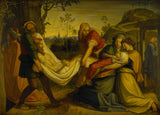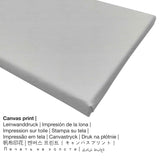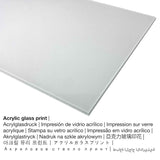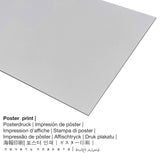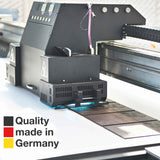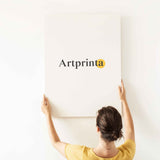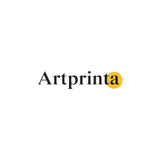Peter Cornelius, 1825 - Ogige nke Kraịst - ọmarịcha nka
Ụtụ gụnyere. Mbupu gbakọrọ na ndenye ọpụpụ.
Nchịkọta nke ihe osise a karịrị afọ 190
The nkà nke oge a nka nka Ebi nke Kraịst was made by the artist Peter Cornelius. The 190 years old version of the piece of art was painted with the size 34,0 x 47,1 cm. Mmanụ na osisi was used by the European painter as the technique for the piece of art. Today, the artpiece is included in the Ụlọ ihe ngosi nka nke Thorvaldsens collection, which is a single-artist museum dedicated to the art of Danish neoclassicistic sculptor Bertel Thorvaldsen. With courtesy of - Peter Cornelius, The Entombment of Christ, 1825, Thorvaldsens Museum, www.thorvaldsensmuseum.dk (ọha na eze).Ebe E Si Nweta nke ihe osise:. N'elu nke ahụ, nhazi nke mmepụta dijitalụ na-abanye odida obodo usoro na oke nke 1.4: 1, nke pụtara na ogologo bụ 40% ogologo karịa obosara. The painter Peter Cornelius was a European artist, whose artistic style was mainly Romanticism. The German painter was born in the year 1783 in Düsseldorf, Northrhine-Westfalia, Germany and deceased at the age of 84 n'afọ 1867.
Nhọrọ akụrụngwa ngwaahịa gị
Maka mbipụta nka ọ bụla anyị na-enye ihe dị iche iche & nha dị iche iche. Ya mere, anyị na-enye gị ohere ịhọrọ n'ime nhọrọ ndị a:
- Mbipụta kwaaji: A printed canvas, which shall not be confused with a canvas painting, is a digital image printed on an industrial printer. It produces the exclusive look of three dimensionality. A canvas print of your favorite artpiece will allow you to transform your into a large size collection piece like you know from art galleries. The great advantage of canvas prints is that they are relatively low in weight. This means, it is quite simple to hang up your Canvas print without the support of any wall-mounts. Canvas prints are suitable for all types of walls.
- Mbipụta ọla (aluminium dibbond): These are metal prints on aluminium dibond material with a true depth - for a modern impression and a non-reflective surface. A direct Aluminium Dibond Print is the best introduction to fine art replicas manufactured on aluminum. Colors are luminous and vivid in the highest definition, the fine details of the print appear clear and crisp, and you can notice the matte appearance. This direct print on Aluminum Dibond is the most popular entry-level product and is a sophisticated way to display fine art reproductions, because it draws attention on the whole artwork.
- Bipụta akwụkwọ mmado n'ihe kwaaji: The Artprinta poster is a UV printed sheet of canvas paper with a slight texture on the surface. Please note, that depending on the absolute size of the poster print we add a white margin of approximately 2 - 6cm round about the artwork, which facilitates the framing with your custom frame.
- Mbipụta iko acrylic (nke nwere ezigbo mkpuchi iko): A glossy acrylic glass print, which is often described as a plexiglass print, will change the original into amazing décor and makes a great alternative to canvas and dibond art prints. The work of art will be custom-made with modern UV print machines. The major benefit of an acrylic glass fine art copy is that contrasts plus details will be more visible thanks to the very fine tonal gradation.
Disclaimer: We try everythig possible to depict the products as clearly as possible and to exhibit them visually. Still, some pigments of the printed materials, as well as the print result can differ to a certain extent from the presentation on the device's screen. Depending on the settings of your screen and the nature of the surface, colors might not be printed 100% realistically. Bearing in mind that all are processed and printed manually, there might as well be minor differences in the exact position and the size of the motif.
Banyere ihe a
| Nkewa bipụta: | ọrụ mgbidi |
| Mmeputakwa: | dijitalụ mmeputakwa |
| Production usoro: | Mbipụta UV ozugbo (mbipụta dijitalụ) |
| Mmalite ngwaahịa: | emere na Germany |
| Ụdị ngwaahịa: | a na-achọ |
| Eji ngwaahịa emebere: | ihe osise nka, nka mgbidi |
| Nhazi nka nka: | nhazi odida obodo |
| Oke akụkụ onyonyo: | 1.4: 1 ogologo ruo obosara |
| Oke akụkụ pụtara: | ogologo bụ 40% ogologo karịa obosara |
| Ụdị ihe dị iche iche dị: | ígwè ebipụta (aluminium dibond), acrylic glass print (nwere ezigbo mkpuchi iko), mbipụta akwụkwọ mmado (akwụkwọ kwaaji), akwụkwọ akwa akwa. |
| Mbipụta kanvas (akwa akwa n'elu etiti ihe ndọtị) ụdị nha dị iche iche: | 70x50cm - 28x20", 140x100cm - 55x39" |
| Mbipụta iko acrylic (nwere ezigbo mkpuchi iko) nhọrọ nha: | 70x50cm - 28x20", 140x100cm - 55x39" |
| Nhọrọ nke mbipụta akwụkwọ mmado (akwụkwọ kwaaji): | 70x50cm - 28x20" |
| Mpempe akwụkwọ Dibony (ihe alumnium) nha dị iche iche: | 70x50cm - 28x20", 140x100cm - 55x39" |
| ụba: | adịghị |
Data ndabere gbasara nka
| Aha nke ihe nka: | "Ozuozu nke Kraịst" |
| Nhazi nke ihe nka: | sere |
| Okwu nche anwụ: | nkà nke oge a |
| Century: | 19th narị afọ |
| Afọ nka: | 1825 |
| Ogologo afọ nka nka: | karịa afọ 190 |
| Usoro nka izizi: | mmanụ n'elu osisi |
| Akụkụ nke ihe osise izizi: | 34,0 x 47,1 cm |
| Egosiputara na: | Ụlọ ihe ngosi nka Thorvaldsens |
| Ebe ebe ngosi nka: | Copenhagen, Denmark |
| ibe weebụ: | Ụlọ ihe ngosi nka Thorvaldsens |
| License: | ngalaba ọha |
| Site n'aka: | Peter Cornelius, The Entombment of Christ, 1825, Thorvaldsens Museum, www.thorvaldsensmuseum.dk |
Ozi omenka
| aha: | Peter Kọniliọs |
| Aha ndi ozo: | Peter von Cornelius, Cornelius Peter |
| okike onye nka: | nwoke |
| Obodo onye nka: | German |
| Ọrụ: | onye na-ese ihe |
| Mba onye si: | Germany |
| Nkewa onye nka: | omenkà nke oge a |
| styles: | Ihunanya |
| Afọ ọnwụ: | 84 afọ |
| A mụrụ: | 1783 |
| Ebe omuma: | Düsseldorf, Northrhine-Westfalia, Germany |
| Afọ ọnwụ: | 1867 |
| Obodo ọnwụ: | Berlin, Berlin State, Germany |
© Nchekwa ikike nwebisiinka - Artprinta.com
Nkọwa ihe osise izizi sitere na webụsaịtị ihe ngosi nka (© Nwebiisinka - Thorvaldsens Museum - www.thorvaldsensmuseum.dk)
The picture is a recreation of Raphael’s The Deposition from 1507 in the Galleria Borghese at Rome. Raphael was considered the greatest artist of all time, but Cornelius, who arrived in Rome in 1811 and joined Overbeck and the Nazarenes, was nevertheless aware that even the art of the incomparable Raphael did not perhaps in every respect live up to the demand for piety that had applied in the Middle Ages and which the Nazarenes were working to re-establish. Whereas Raphael’s version is characterised by almost heroic action, Cornelius allows a simple, quiet sorrow to descend on his scene. Cornelius was born at Düsseldorf and left Rome in 1819 because he had been appointed Director of the Academy of Fine Arts in his native city. At the same time he was given the commission by Ludwig of Bavaria to decorate the Glyptotek at Munich, and in 1824 he was appointed Director of the Academy there. His importance for German painting in the 19th century was enormous.

